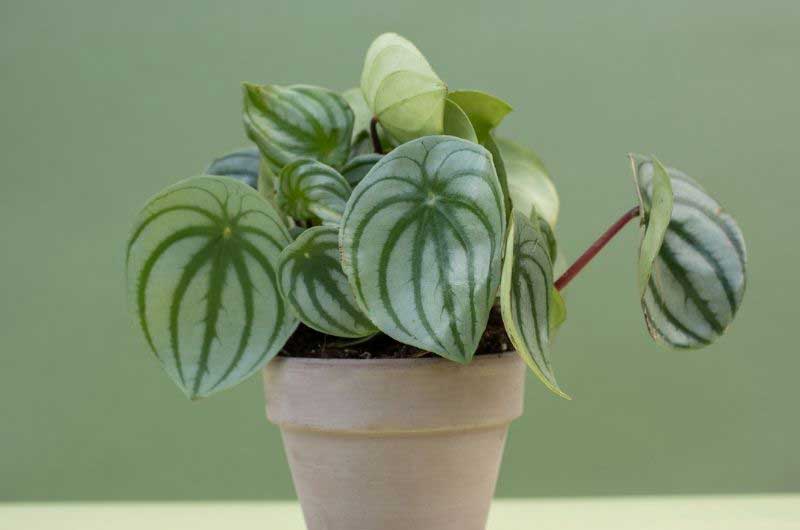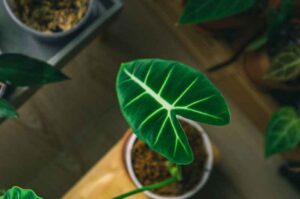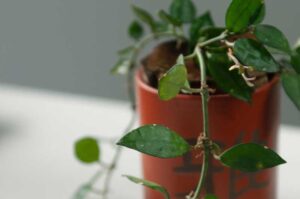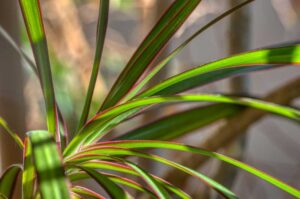10 Causes Of Watermelon Peperomia Drooping (With Solutions)
Watermelon Peperomias are beautiful household plants that require minimum maintenance. However, they sometimes exhibit dramatic wilting. If you notice your Watermelon Peperomia drooping, you can easily find the identifiable cause. Once you know the reason, promptly fix the drooping Peperomia; or else, the plant may die.
The most common reasons your Watermelon Peperomia are drooping are under watering and low humidity. The other causes include pest infestation, overwatering leading to root rot, and extreme temperatures.
However, it’s easy to revive the drooping Peperomia by keeping your plant hydrated, enhancing the soil drainage, and protecting the plants from pest infestation.

How Do You Save A Droopy Watermelon Peperomia?
You can fix the wilting of Watermelon Peperomia by assessing its growing conditions and fixing the possible issues causing the drooping.
- Check the soil– Check if the soil is wet enough to provide enough moisture and not soggy.
- Adjust plant location– Adjust the plant location by assessing its growing conditions, and ensure that your plant is getting enough medium to bright indirect light.
- Check the pot you are using– Check for drainage holes in the pot for proper water drainage.
- Examine the humidity levels– Humidity levels below 50% may cause drooping leaves.
- Check for pest infestation– Check for any colored spots and rings on the leaves. Give the infected plant an immediate treatment before it dies.
Causes and Solutions Of Watermelon Peperomia Drooping
1. Overwatering
Overwatering is one of the significant reasons for the drooping of Watermelon Peperomia. If the plant’s stems are soggy, floppy and the leaves appear to be yellow and wilting; then you probably are overwatering your plant.
The soil of Peperomia should be held loose and have enough chunks to allow proper aeration. However, if you keep filling these spaces with water, there would be no space left for the roots to get air.
Eventually, the roots will rot and fail to deliver nutrients to plants. Thus the plant will droop and soon die.
Solutions
- If you notice any indications of root rot, gently take the plant out of the pot and cut off the infected roots.
- Always plant your Peperomias in a pot adequate for the plant. A large pot will hold an excess amount of water, and a small pot can stunt growth.
- Make sure to use well-draining potting soil, that will help to drain out extra water quickly.
2. Pest Infestations
Watermelon Peperomias are generally resistant to pests, but they can get heavy infestation quickly if you expose them to outdoor pests. For example, if you get an infected plant from the greenhouse, outdoors, or store, the chances of Peperomias getting the infestation are very high.
Once infested, they show symptoms like yellow leaves and plant drooping.
Common pests that infect household plants are whiteflies, mealy bugs, and spider mites.
Moreover, in summers, if you leave your plants outside, they quickly get infected by fungus gnats, thrips, and scales. Also, slugs, caterpillars, and snails eagerly wait to crew holes in Peperomia leaves.
Solutions
- Carefully examine your plants, leaves, stems, and soil for any visible sign of pests.
- Wipe the visible pests off the plant.
- You can run the plant under warm water to get rid of pests.
- Spraying your plants with diluted liquid soaps can kill these bugs.
- Neem oil is also a great choice to knock the pests off the plants.
3. Dusty leaves
If you leave your plant unattended for a long time, the leaves may collect dust on their surface. This dust causes a hindrance in maximum sunlight absorption by the plant.
Moreover, it hampers the process of transpiration and gaseous exchange through stomata.
Ultimately to photosynthesis process will be hampered and the plant will lose its turgidity and start drooping.
Solutions
- Wash the leaves with lukewarm water.
- Wipe them regularly with a moist paper towel.
4. Diseases Attack
Although Watermelon Peperomia is susceptible to severe diseases, it can still get infected with edema, cutting rot, ringspot, and Phytophthora rot. Fortunately, you can quickly cure these diseases if you take proper care of your plant.
Ringspot
Cause: Virus
Symptoms: Brown ring spots occur as concentric circles on the leaves, causing the young leaves to disfigure.
Control:
- Since the plants do not recover, discard them as soon as you see the infection.
- Take plant cuttings from a healthy and known plant.
- Sterilize the soil properly before propagating.
- Keep the infected plants aside as they may infect the healthy plants also.
Edema
Cause: Unknown, though some studies suggest virus.
Symptoms: Pimple-like areas on each side of the leaf
Control: similar to ringspot.
Phytophthora rot
Cause: Fungi (soilborne) Phytophthora palmivora, P. nicottianae
Symptoms: Stem blackens at the soil line, the stem rots eventually.
Control:
- Destroy the infected plant
- Avoid overwatering
- Take cuttings from uninfected, healthy plant
- Sterilize the sand, propagation boxes, soil mixtures, and pots before you plant your cuttings into them.
Cutting rot
Cause: Soilborne fungi Phytophthora palmivora, P. nicottianae, Rhizoctonia solani, and Pythium species.
Symptoms: Decayed roots, dark brownish and black water-soaked spots in petioles.
Control: The preventive measures are similar to Phytophthora rot.
Solutions
- Keep the infected Peperomia in isolation from healthy ones.
- Cut off the infected leaves
- Check the visible signs of root rotting.
- If you notice any root rot, prune the root off and wash away all the affected soil from the healthy roots.
- Spray fungicide on the infected roots. You can also try the diluted solution of hydrogen peroxide.
- Change the pot and plant the Peperomia in a new pot with fresh soil.
5. Underwatering
Underwatering is yet another common reason for Peperomia drooping. When the plants have enough water, they stand firm. But plants continuously breathe water vapors out, so when there is scarce water for tissue replenishment, the plants begin showing distress.
Now your dehydrated Peperomia doesn’t stand upright but sags down because it has lost its turgidity.
Though these plants don’t like to be moist, they equally hate being dry.
Solutions
- Keep a check on your plant’s needs; make sure to water it regularly.
- Before watering, check if the soil is dry or has enough moisture by digging your fingers in the soil.
- You can lift the pot to check for the weight. An adequately watered plant will be heavy compared to an underwatered plant.
- While watering, ensure to soak the soil in water thoroughly. When you do so, water will seep out of the drainage holes.
6. Temperature stress
The ideal temperature range for your Watermelon Peperomias is between 15o C to 27o C (60o F-80o F). These plants can neither withstand very high temperatures nor low, freezing temperatures.
A temperature below 10o C (50o F) can cause the plants to stress, followed by leaves curling, drooping and wilting.
In high temperatures, the leaves start to curl and roll. Sometimes they may have dry edges and leaf scald. Moreover, the plants exhibit rapid growth to become leggy. Also, placing them under direct sunlight (80o F) can cause burning of the leaves and eventually drooping.
Solutions
- You can place a digital thermometer near your plants.
- As soon as you see a rise or drop in temperature levels, make necessary adjustments for your plants.
7. Repotting shock
Whenever you repot a plant, it undergoes a shock that is known as repotting shock. Due to the soil and environmental change, the plant adjusts and adapts to the changing environment. So your plant can droop a little before it reconciles into the new soil.
It is a normal process and you shouldn’t worry much about it.
Solutions
- Ensure that you adjust the growing conditions of Peperomias.
- Moisten the soil mix.
- Maintain humidity levels. You can try making a tiny greenhouse over the plant to maximize humidity.
8. Acclimation
Some plants do not accept their abrupt environmental changes. So they may dramatically wilt when you first bring them home.
Moreover, plants can undergo shock while you bring them home from the stores. It may be due to the very hot or cold temperature the plants get exposed to on their journey.
In addition, sometimes the plants are not taken proper care of, in the stores and the effects are visible only when you bring them home.
Plants will take some time to adapt according to your home environment.
Solutions
- Prefer buying the plants from reputed sellers
- Select plants that look good in condition; else, they’ll die after some time.
- While bringing the plants home, try maintaining comfortable temperatures.
- At home, take proper care of them. Avoid direct sunlight, don’t let the soil dry out, and maintain humidity levels
9. Over-fertilizing
Over-fertilizing can also adversely affect your plant because the salts in fertilizers pull out the moisture from roots. It causes the plant to burn as the roots lose their ability to retain water in them. It leads to a dry plant, yellowing leaves, leaf tips turning brown, and leaf droop.
Solutions
- The first step is to remove the dead or blackened roots
- Next, remove the extra fertilizer by flushing it with water
- Or you can repot Peperomia in the fresh soil mix.
- Avoid fertilizing the plant for at least the next one or two months.
- Next time you fertilize the plant, make sure to dilute it.
10. Low humidity
Household humidity levels are perfect for these plants, but they start drooping as soon as the humidity levels become low.
The humidity is usually low in winters because most of us use heaters. In this scenario, the plant tries to conserve its moisture by either curling the leaves or drooping them. They do so because the less the surface area, the more they can retain the moisture.
Since Peperomias are the natives of tropical and subtropical locations where the humidity levels are high, these plants bloom well in high humidity areas.
Solutions
- You can keep a hygrometer indoors to keep a check on your home’s humidity.
- Maintain the humidity level above 50%.
- If your indoor humidity is low, try using a humidifier
- You can try grouping the plants to increase the humidity
- You can also mist the plants to enhance it.
Final Words
Growing houseplants may be tricky at times due to the possible hazards they are exposed to. But if you take proper care of them, you can avoid the drooping and killing of the plants. A healthy, blooming, and the thriving plant gives you happy moments.






